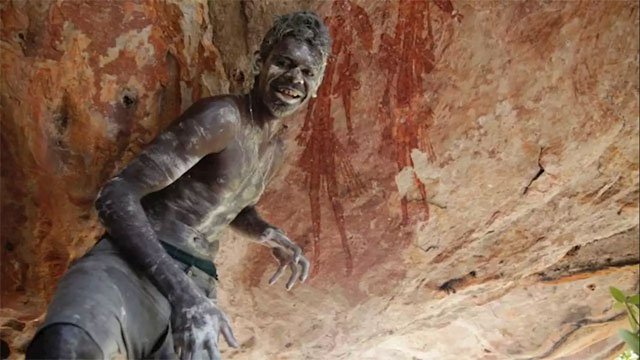The wasps' hives help determine the age of cave paintings in Australia
According to ABCNews, a new study shows that Aboriginal Australian rock paintings in the Kimberley district of Western Australia were created about 12,000 years ago. The wasps' hives helped determine the age of the paintings.
The first European to see the Kimberley County stone paintings was Joseph Bradshaw. In 1891, he bought a large area of the area and started raising sheep. Later, scientists named this rock art style Bradshaw rock art, Bradshaw figures or The Bradshaws in his honor.

Gwion paintings created by Balanggarra ancestors - (Image: Mark Jones)
In the language of indigenous Australians, these paintings are called gwion, kiro kiro or kujon . Today, scientists know more than 8,000 paintings in this style. Most of these are figures of 40-50 cm in size, but there are also some figures of a height of 2m.
The pigments used to create rock paintings that do not contain organic materials can be used for radiocarbon dating. In many cases, when cave painting is located in a karst cave, calcite formation from the limestone below and above the pigment layer is used to date.
Calcite age is determined by uranium-thorium method . But "Bradshaw figures" were painted on sandstone and did not contain calcite. However, scientists were able to find objects that could be used to determine the age of paintings.
Some species of wasps from the Sphecidae and Crabronidae families build nests in the form of tubes, the walls of which are formed from soil particles. The coal particles left over from fires in the Australian steppe during the dry season blend into the soil composition, which means their age can be determined by radioactive carbon.
Scientists were able to spot traces of 24 beehives in Drysdale River National Park, located under a layer of pigment on the rock paintings or just above it. As a result, most of the rock paintings were created in a relatively short period of 12,000 ± 500 years ago, but there is also a picture that is more than 16,000 years old.
- The strange pattern is a UFO on a 400-year-old mural
- Picture of devouring fish in synagogue of the 5th century
- Find the world's oldest artwork in a cave in Indonesia
- Mexico discovered 5000 ancient paintings in the cave
- Mysterious handprints in ancient cave
- The oldest rock art in Australia
- Unexpected discovery: the oldest cave art belongs to Neanderthals
- Surprise the world's oldest painting discovered in cave ... Indonesia
- Life of wasps
- The oldest drawings of humanity
- The wasps knock down giant spiders, dragging toward the nest
- Spain discovered dozens of paintings on rock dating back to 14,000 years
- The true meaning of world famous paintings that most of us do not know
- Shocking discovery: Asia is the cradle of art
 Discovered an ancient centipede fossil 99 million years old
Discovered an ancient centipede fossil 99 million years old Discovered bat-like dinosaurs in China
Discovered bat-like dinosaurs in China Discovered a 200-year-old bronze cannon of the coast
Discovered a 200-year-old bronze cannon of the coast Discover 305 million-year-old spider fossils
Discover 305 million-year-old spider fossils